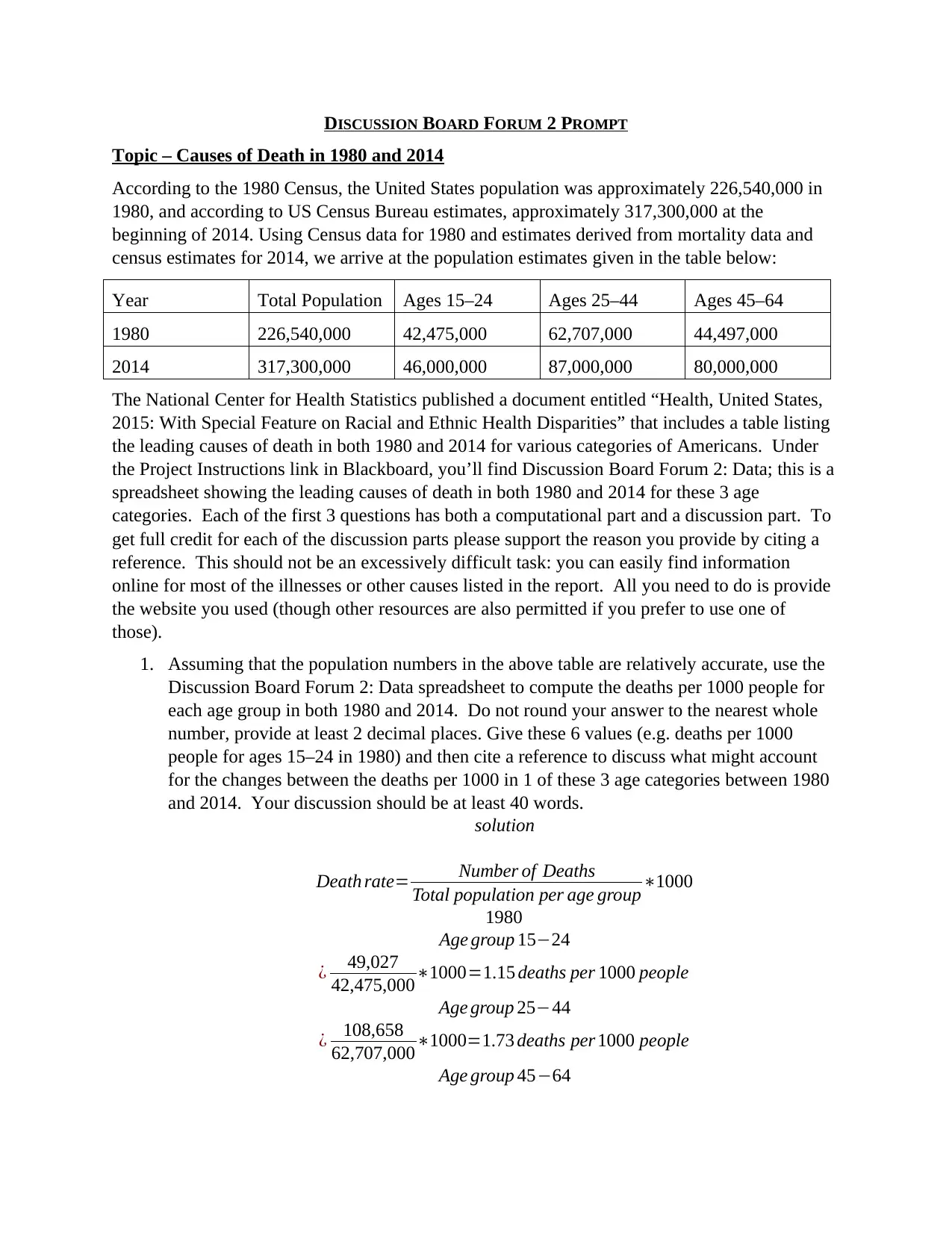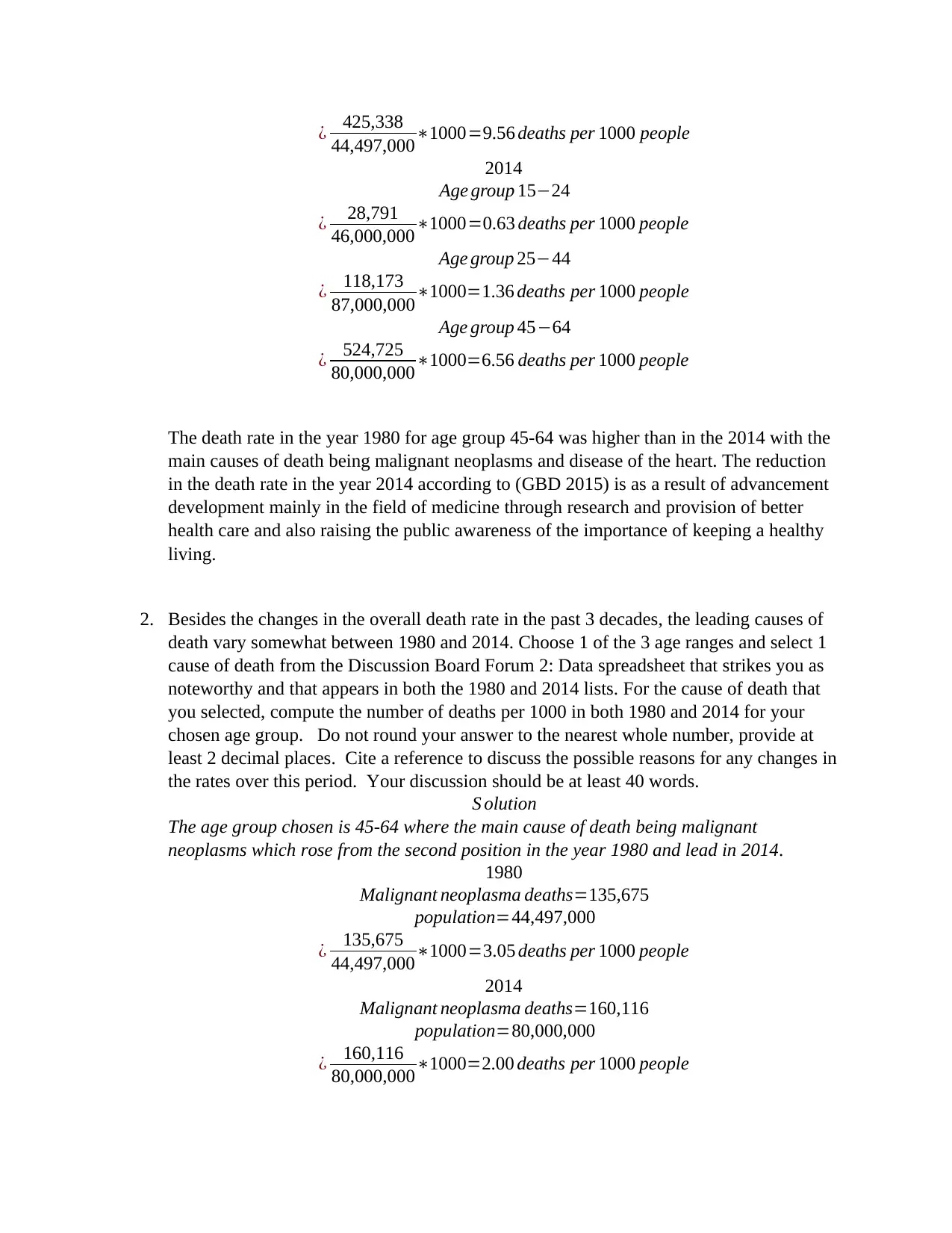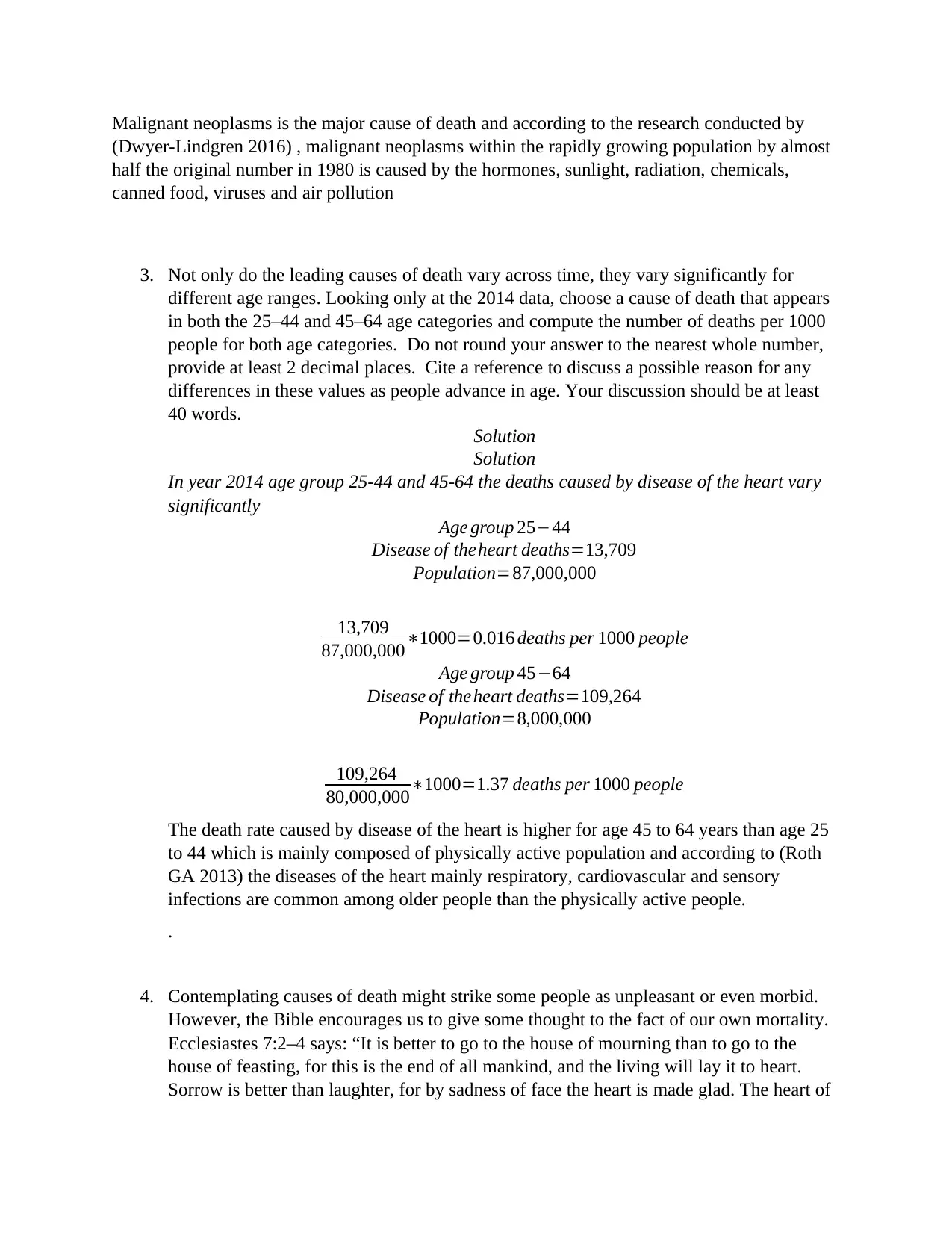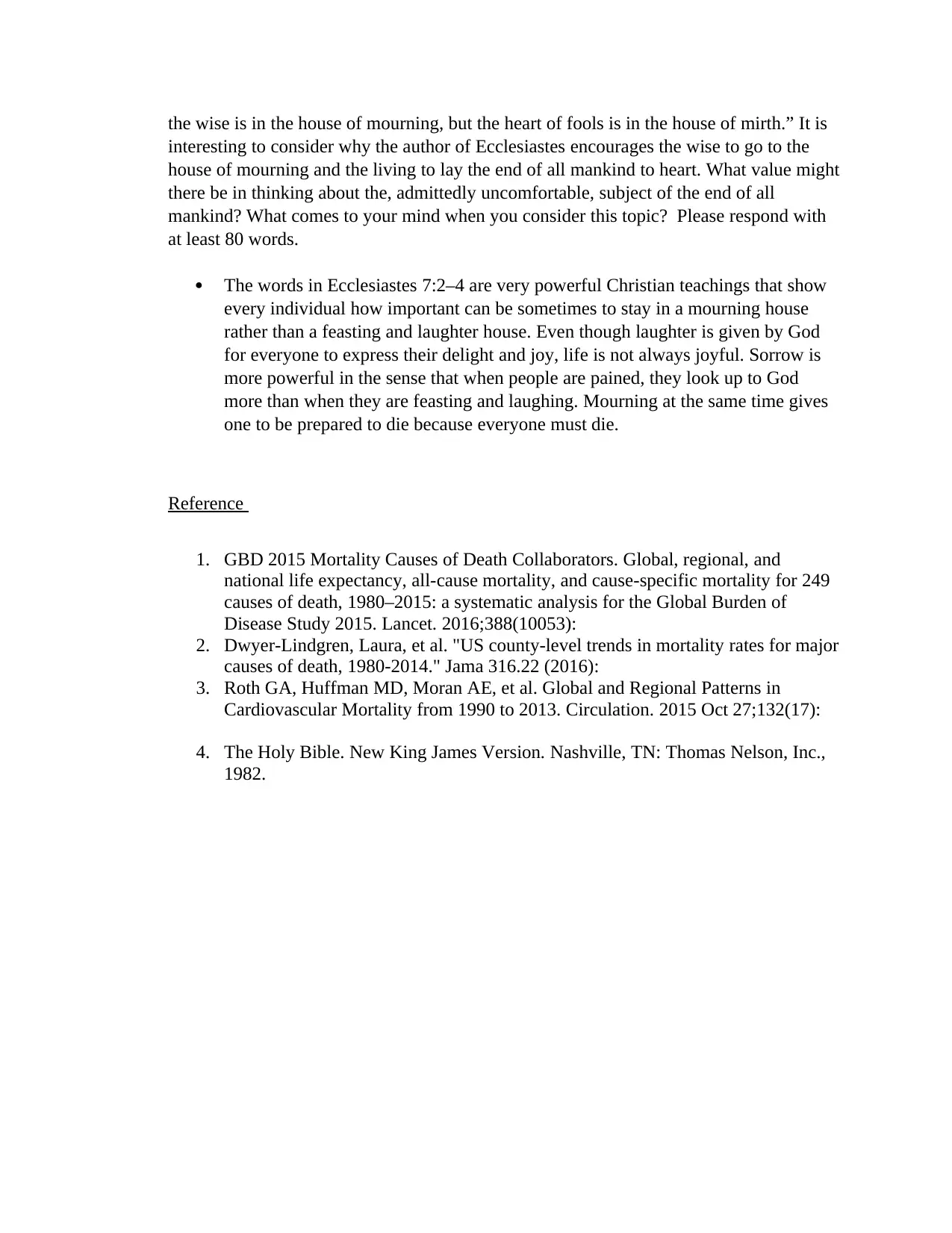MATH 114 Discussion Board Forum 2: Causes of Death Comparison
VerifiedAdded on 2023/03/17
|4
|1457
|99
Discussion Board Post
AI Summary
This discussion board post analyzes the causes of death in the United States in 1980 and 2014, utilizing census data and mortality statistics. The assignment involves calculating death rates per 1000 people for different age groups (15-24, 25-44, and 45-64) and comparing the leading causes of death during these two periods. The analysis includes identifying noteworthy changes in death rates for specific causes, such as malignant neoplasms and heart disease, and discussing potential contributing factors like advancements in medical care, public awareness, and lifestyle changes. The assignment also considers the philosophical implications of mortality, referencing Ecclesiastes and encouraging reflection on the value of contemplating the end of life. The student provides calculations, discusses the observed trends, and supports their arguments with cited references.

DISCUSSION BOARD FORUM 2 PROMPT
Topic – Causes of Death in 1980 and 2014
According to the 1980 Census, the United States population was approximately 226,540,000 in
1980, and according to US Census Bureau estimates, approximately 317,300,000 at the
beginning of 2014. Using Census data for 1980 and estimates derived from mortality data and
census estimates for 2014, we arrive at the population estimates given in the table below:
Year Total Population Ages 15–24 Ages 25–44 Ages 45–64
1980 226,540,000 42,475,000 62,707,000 44,497,000
2014 317,300,000 46,000,000 87,000,000 80,000,000
The National Center for Health Statistics published a document entitled “Health, United States,
2015: With Special Feature on Racial and Ethnic Health Disparities” that includes a table listing
the leading causes of death in both 1980 and 2014 for various categories of Americans. Under
the Project Instructions link in Blackboard, you’ll find Discussion Board Forum 2: Data; this is a
spreadsheet showing the leading causes of death in both 1980 and 2014 for these 3 age
categories. Each of the first 3 questions has both a computational part and a discussion part. To
get full credit for each of the discussion parts please support the reason you provide by citing a
reference. This should not be an excessively difficult task: you can easily find information
online for most of the illnesses or other causes listed in the report. All you need to do is provide
the website you used (though other resources are also permitted if you prefer to use one of
those).
1. Assuming that the population numbers in the above table are relatively accurate, use the
Discussion Board Forum 2: Data spreadsheet to compute the deaths per 1000 people for
each age group in both 1980 and 2014. Do not round your answer to the nearest whole
number, provide at least 2 decimal places. Give these 6 values (e.g. deaths per 1000
people for ages 15–24 in 1980) and then cite a reference to discuss what might account
for the changes between the deaths per 1000 in 1 of these 3 age categories between 1980
and 2014. Your discussion should be at least 40 words.
solution
Death rate= Number of Deaths
Total population per age group∗1000
1980
Age group 15−24
¿ 49,027
42,475,000∗1000=1.15 deaths per 1000 people
Age group 25−44
¿ 108,658
62,707,000∗1000=1.73 deaths per 1000 people
Age group 45−64
Topic – Causes of Death in 1980 and 2014
According to the 1980 Census, the United States population was approximately 226,540,000 in
1980, and according to US Census Bureau estimates, approximately 317,300,000 at the
beginning of 2014. Using Census data for 1980 and estimates derived from mortality data and
census estimates for 2014, we arrive at the population estimates given in the table below:
Year Total Population Ages 15–24 Ages 25–44 Ages 45–64
1980 226,540,000 42,475,000 62,707,000 44,497,000
2014 317,300,000 46,000,000 87,000,000 80,000,000
The National Center for Health Statistics published a document entitled “Health, United States,
2015: With Special Feature on Racial and Ethnic Health Disparities” that includes a table listing
the leading causes of death in both 1980 and 2014 for various categories of Americans. Under
the Project Instructions link in Blackboard, you’ll find Discussion Board Forum 2: Data; this is a
spreadsheet showing the leading causes of death in both 1980 and 2014 for these 3 age
categories. Each of the first 3 questions has both a computational part and a discussion part. To
get full credit for each of the discussion parts please support the reason you provide by citing a
reference. This should not be an excessively difficult task: you can easily find information
online for most of the illnesses or other causes listed in the report. All you need to do is provide
the website you used (though other resources are also permitted if you prefer to use one of
those).
1. Assuming that the population numbers in the above table are relatively accurate, use the
Discussion Board Forum 2: Data spreadsheet to compute the deaths per 1000 people for
each age group in both 1980 and 2014. Do not round your answer to the nearest whole
number, provide at least 2 decimal places. Give these 6 values (e.g. deaths per 1000
people for ages 15–24 in 1980) and then cite a reference to discuss what might account
for the changes between the deaths per 1000 in 1 of these 3 age categories between 1980
and 2014. Your discussion should be at least 40 words.
solution
Death rate= Number of Deaths
Total population per age group∗1000
1980
Age group 15−24
¿ 49,027
42,475,000∗1000=1.15 deaths per 1000 people
Age group 25−44
¿ 108,658
62,707,000∗1000=1.73 deaths per 1000 people
Age group 45−64
Paraphrase This Document
Need a fresh take? Get an instant paraphrase of this document with our AI Paraphraser

¿ 425,338
44,497,000∗1000=9.56 deaths per 1000 people
2014
Age group 15−24
¿ 28,791
46,000,000∗1000=0.63 deaths per 1000 people
Age group 25−44
¿ 118,173
87,000,000∗1000=1.36 deaths per 1000 people
Age group 45−64
¿ 524,725
80,000,000∗1000=6.56 deaths per 1000 people
The death rate in the year 1980 for age group 45-64 was higher than in the 2014 with the
main causes of death being malignant neoplasms and disease of the heart. The reduction
in the death rate in the year 2014 according to (GBD 2015) is as a result of advancement
development mainly in the field of medicine through research and provision of better
health care and also raising the public awareness of the importance of keeping a healthy
living.
2. Besides the changes in the overall death rate in the past 3 decades, the leading causes of
death vary somewhat between 1980 and 2014. Choose 1 of the 3 age ranges and select 1
cause of death from the Discussion Board Forum 2: Data spreadsheet that strikes you as
noteworthy and that appears in both the 1980 and 2014 lists. For the cause of death that
you selected, compute the number of deaths per 1000 in both 1980 and 2014 for your
chosen age group. Do not round your answer to the nearest whole number, provide at
least 2 decimal places. Cite a reference to discuss the possible reasons for any changes in
the rates over this period. Your discussion should be at least 40 words.
S olution
The age group chosen is 45-64 where the main cause of death being malignant
neoplasms which rose from the second position in the year 1980 and lead in 2014.
1980
Malignant neoplasma deaths=135,675
population=44,497,000
¿ 135,675
44,497,000∗1000=3.05 deaths per 1000 people
2014
Malignant neoplasma deaths=160,116
population=80,000,000
¿ 160,116
80,000,000∗1000=2.00 deaths per 1000 people
44,497,000∗1000=9.56 deaths per 1000 people
2014
Age group 15−24
¿ 28,791
46,000,000∗1000=0.63 deaths per 1000 people
Age group 25−44
¿ 118,173
87,000,000∗1000=1.36 deaths per 1000 people
Age group 45−64
¿ 524,725
80,000,000∗1000=6.56 deaths per 1000 people
The death rate in the year 1980 for age group 45-64 was higher than in the 2014 with the
main causes of death being malignant neoplasms and disease of the heart. The reduction
in the death rate in the year 2014 according to (GBD 2015) is as a result of advancement
development mainly in the field of medicine through research and provision of better
health care and also raising the public awareness of the importance of keeping a healthy
living.
2. Besides the changes in the overall death rate in the past 3 decades, the leading causes of
death vary somewhat between 1980 and 2014. Choose 1 of the 3 age ranges and select 1
cause of death from the Discussion Board Forum 2: Data spreadsheet that strikes you as
noteworthy and that appears in both the 1980 and 2014 lists. For the cause of death that
you selected, compute the number of deaths per 1000 in both 1980 and 2014 for your
chosen age group. Do not round your answer to the nearest whole number, provide at
least 2 decimal places. Cite a reference to discuss the possible reasons for any changes in
the rates over this period. Your discussion should be at least 40 words.
S olution
The age group chosen is 45-64 where the main cause of death being malignant
neoplasms which rose from the second position in the year 1980 and lead in 2014.
1980
Malignant neoplasma deaths=135,675
population=44,497,000
¿ 135,675
44,497,000∗1000=3.05 deaths per 1000 people
2014
Malignant neoplasma deaths=160,116
population=80,000,000
¿ 160,116
80,000,000∗1000=2.00 deaths per 1000 people

Malignant neoplasms is the major cause of death and according to the research conducted by
(Dwyer-Lindgren 2016) , malignant neoplasms within the rapidly growing population by almost
half the original number in 1980 is caused by the hormones, sunlight, radiation, chemicals,
canned food, viruses and air pollution
3. Not only do the leading causes of death vary across time, they vary significantly for
different age ranges. Looking only at the 2014 data, choose a cause of death that appears
in both the 25–44 and 45–64 age categories and compute the number of deaths per 1000
people for both age categories. Do not round your answer to the nearest whole number,
provide at least 2 decimal places. Cite a reference to discuss a possible reason for any
differences in these values as people advance in age. Your discussion should be at least
40 words.
Solution
Solution
In year 2014 age group 25-44 and 45-64 the deaths caused by disease of the heart vary
significantly
Age group 25−44
Disease of theheart deaths=13,709
Population=87,000,000
13,709
87,000,000∗1000=0.016 deaths per 1000 people
Age group 45−64
Disease of theheart deaths=109,264
Population=8,000,000
109,264
80,000,000∗1000=1.37 deaths per 1000 people
The death rate caused by disease of the heart is higher for age 45 to 64 years than age 25
to 44 which is mainly composed of physically active population and according to (Roth
GA 2013) the diseases of the heart mainly respiratory, cardiovascular and sensory
infections are common among older people than the physically active people.
.
4. Contemplating causes of death might strike some people as unpleasant or even morbid.
However, the Bible encourages us to give some thought to the fact of our own mortality.
Ecclesiastes 7:2–4 says: “It is better to go to the house of mourning than to go to the
house of feasting, for this is the end of all mankind, and the living will lay it to heart.
Sorrow is better than laughter, for by sadness of face the heart is made glad. The heart of
(Dwyer-Lindgren 2016) , malignant neoplasms within the rapidly growing population by almost
half the original number in 1980 is caused by the hormones, sunlight, radiation, chemicals,
canned food, viruses and air pollution
3. Not only do the leading causes of death vary across time, they vary significantly for
different age ranges. Looking only at the 2014 data, choose a cause of death that appears
in both the 25–44 and 45–64 age categories and compute the number of deaths per 1000
people for both age categories. Do not round your answer to the nearest whole number,
provide at least 2 decimal places. Cite a reference to discuss a possible reason for any
differences in these values as people advance in age. Your discussion should be at least
40 words.
Solution
Solution
In year 2014 age group 25-44 and 45-64 the deaths caused by disease of the heart vary
significantly
Age group 25−44
Disease of theheart deaths=13,709
Population=87,000,000
13,709
87,000,000∗1000=0.016 deaths per 1000 people
Age group 45−64
Disease of theheart deaths=109,264
Population=8,000,000
109,264
80,000,000∗1000=1.37 deaths per 1000 people
The death rate caused by disease of the heart is higher for age 45 to 64 years than age 25
to 44 which is mainly composed of physically active population and according to (Roth
GA 2013) the diseases of the heart mainly respiratory, cardiovascular and sensory
infections are common among older people than the physically active people.
.
4. Contemplating causes of death might strike some people as unpleasant or even morbid.
However, the Bible encourages us to give some thought to the fact of our own mortality.
Ecclesiastes 7:2–4 says: “It is better to go to the house of mourning than to go to the
house of feasting, for this is the end of all mankind, and the living will lay it to heart.
Sorrow is better than laughter, for by sadness of face the heart is made glad. The heart of
⊘ This is a preview!⊘
Do you want full access?
Subscribe today to unlock all pages.

Trusted by 1+ million students worldwide

the wise is in the house of mourning, but the heart of fools is in the house of mirth.” It is
interesting to consider why the author of Ecclesiastes encourages the wise to go to the
house of mourning and the living to lay the end of all mankind to heart. What value might
there be in thinking about the, admittedly uncomfortable, subject of the end of all
mankind? What comes to your mind when you consider this topic? Please respond with
at least 80 words.
The words in Ecclesiastes 7:2–4 are very powerful Christian teachings that show
every individual how important can be sometimes to stay in a mourning house
rather than a feasting and laughter house. Even though laughter is given by God
for everyone to express their delight and joy, life is not always joyful. Sorrow is
more powerful in the sense that when people are pained, they look up to God
more than when they are feasting and laughing. Mourning at the same time gives
one to be prepared to die because everyone must die.
Reference
1. GBD 2015 Mortality Causes of Death Collaborators. Global, regional, and
national life expectancy, all-cause mortality, and cause-specific mortality for 249
causes of death, 1980–2015: a systematic analysis for the Global Burden of
Disease Study 2015. Lancet. 2016;388(10053):
2. Dwyer-Lindgren, Laura, et al. "US county-level trends in mortality rates for major
causes of death, 1980-2014." Jama 316.22 (2016):
3. Roth GA, Huffman MD, Moran AE, et al. Global and Regional Patterns in
Cardiovascular Mortality from 1990 to 2013. Circulation. 2015 Oct 27;132(17):
4. The Holy Bible. New King James Version. Nashville, TN: Thomas Nelson, Inc.,
1982.
interesting to consider why the author of Ecclesiastes encourages the wise to go to the
house of mourning and the living to lay the end of all mankind to heart. What value might
there be in thinking about the, admittedly uncomfortable, subject of the end of all
mankind? What comes to your mind when you consider this topic? Please respond with
at least 80 words.
The words in Ecclesiastes 7:2–4 are very powerful Christian teachings that show
every individual how important can be sometimes to stay in a mourning house
rather than a feasting and laughter house. Even though laughter is given by God
for everyone to express their delight and joy, life is not always joyful. Sorrow is
more powerful in the sense that when people are pained, they look up to God
more than when they are feasting and laughing. Mourning at the same time gives
one to be prepared to die because everyone must die.
Reference
1. GBD 2015 Mortality Causes of Death Collaborators. Global, regional, and
national life expectancy, all-cause mortality, and cause-specific mortality for 249
causes of death, 1980–2015: a systematic analysis for the Global Burden of
Disease Study 2015. Lancet. 2016;388(10053):
2. Dwyer-Lindgren, Laura, et al. "US county-level trends in mortality rates for major
causes of death, 1980-2014." Jama 316.22 (2016):
3. Roth GA, Huffman MD, Moran AE, et al. Global and Regional Patterns in
Cardiovascular Mortality from 1990 to 2013. Circulation. 2015 Oct 27;132(17):
4. The Holy Bible. New King James Version. Nashville, TN: Thomas Nelson, Inc.,
1982.
1 out of 4
Related Documents
Your All-in-One AI-Powered Toolkit for Academic Success.
+13062052269
info@desklib.com
Available 24*7 on WhatsApp / Email
![[object Object]](/_next/static/media/star-bottom.7253800d.svg)
Unlock your academic potential
Copyright © 2020–2025 A2Z Services. All Rights Reserved. Developed and managed by ZUCOL.





